Jacopo Bono
Mind the truncation gap: challenges of learning on dynamic graphs with recurrent architectures
Dec 30, 2024



Abstract:Systems characterized by evolving interactions, prevalent in social, financial, and biological domains, are effectively modeled as continuous-time dynamic graphs (CTDGs). To manage the scale and complexity of these graph datasets, machine learning (ML) approaches have become essential. However, CTDGs pose challenges for ML because traditional static graph methods do not naturally account for event timings. Newer approaches, such as graph recurrent neural networks (GRNNs), are inherently time-aware and offer advantages over static methods for CTDGs. However, GRNNs face another issue: the short truncation of backpropagation-through-time (BPTT), whose impact has not been properly examined until now. In this work, we demonstrate that this truncation can limit the learning of dependencies beyond a single hop, resulting in reduced performance. Through experiments on a novel synthetic task and real-world datasets, we reveal a performance gap between full backpropagation-through-time (F-BPTT) and the truncated backpropagation-through-time (T-BPTT) commonly used to train GRNN models. We term this gap the "truncation gap" and argue that understanding and addressing it is essential as the importance of CTDGs grows, discussing potential future directions for research in this area.
Deep-Graph-Sprints: Accelerated Representation Learning in Continuous-Time Dynamic Graphs
Jul 10, 2024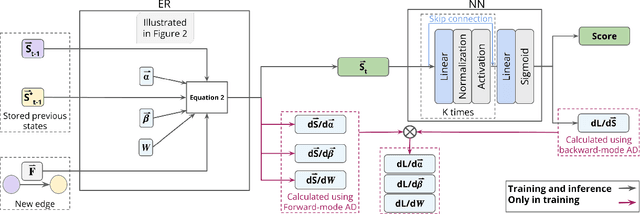



Abstract:Continuous-time dynamic graphs (CTDGs) are essential for modeling interconnected, evolving systems. Traditional methods for extracting knowledge from these graphs often depend on feature engineering or deep learning. Feature engineering is limited by the manual and time-intensive nature of crafting features, while deep learning approaches suffer from high inference latency, making them impractical for real-time applications. This paper introduces Deep-Graph-Sprints (DGS), a novel deep learning architecture designed for efficient representation learning on CTDGs with low-latency inference requirements. We benchmark DGS against state-of-the-art feature engineering and graph neural network methods using five diverse datasets. The results indicate that DGS achieves competitive performance while improving inference speed up to 12x compared to other deep learning approaches on our tested benchmarks. Our method effectively bridges the gap between deep representation learning and low-latency application requirements for CTDGs.
DiConStruct: Causal Concept-based Explanations through Black-Box Distillation
Jan 26, 2024
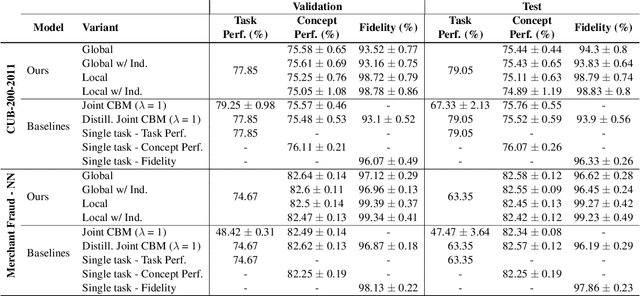
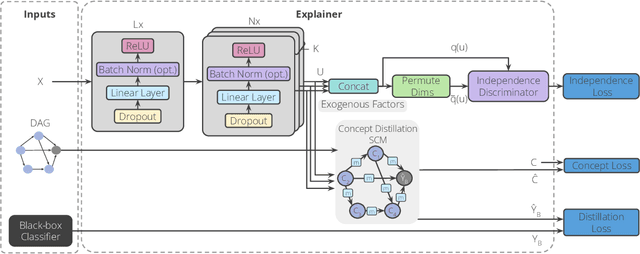
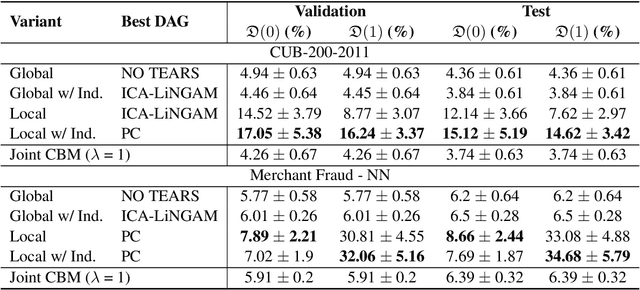
Abstract:Model interpretability plays a central role in human-AI decision-making systems. Ideally, explanations should be expressed using human-interpretable semantic concepts. Moreover, the causal relations between these concepts should be captured by the explainer to allow for reasoning about the explanations. Lastly, explanation methods should be efficient and not compromise the performance of the predictive task. Despite the rapid advances in AI explainability in recent years, as far as we know to date, no method fulfills these three properties. Indeed, mainstream methods for local concept explainability do not produce causal explanations and incur a trade-off between explainability and prediction performance. We present DiConStruct, an explanation method that is both concept-based and causal, with the goal of creating more interpretable local explanations in the form of structural causal models and concept attributions. Our explainer works as a distillation model to any black-box machine learning model by approximating its predictions while producing the respective explanations. Because of this, DiConStruct generates explanations efficiently while not impacting the black-box prediction task. We validate our method on an image dataset and a tabular dataset, showing that DiConStruct approximates the black-box models with higher fidelity than other concept explainability baselines, while providing explanations that include the causal relations between the concepts.
The GANfather: Controllable generation of malicious activity to improve defence systems
Jul 25, 2023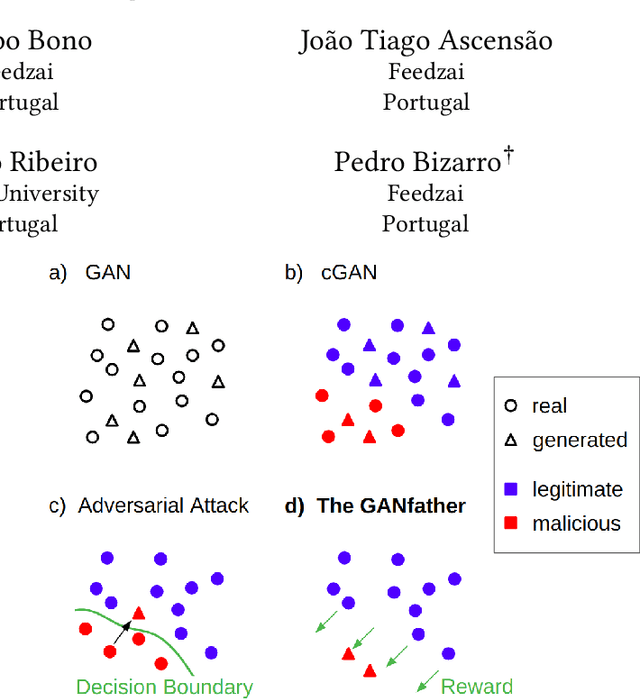

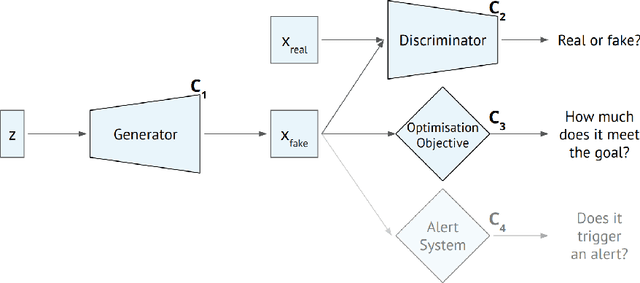
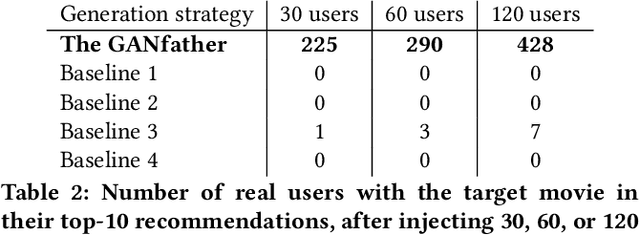
Abstract:Machine learning methods to aid defence systems in detecting malicious activity typically rely on labelled data. In some domains, such labelled data is unavailable or incomplete. In practice this can lead to low detection rates and high false positive rates, which characterise for example anti-money laundering systems. In fact, it is estimated that 1.7--4 trillion euros are laundered annually and go undetected. We propose The GANfather, a method to generate samples with properties of malicious activity, without label requirements. We propose to reward the generation of malicious samples by introducing an extra objective to the typical Generative Adversarial Networks (GANs) loss. Ultimately, our goal is to enhance the detection of illicit activity using the discriminator network as a novel and robust defence system. Optionally, we may encourage the generator to bypass pre-existing detection systems. This setup then reveals defensive weaknesses for the discriminator to correct. We evaluate our method in two real-world use cases, money laundering and recommendation systems. In the former, our method moves cumulative amounts close to 350 thousand dollars through a network of accounts without being detected by an existing system. In the latter, we recommend the target item to a broad user base with as few as 30 synthetic attackers. In both cases, we train a new defence system to capture the synthetic attacks.
From random-walks to graph-sprints: a low-latency node embedding framework on continuous-time dynamic graphs
Jul 18, 2023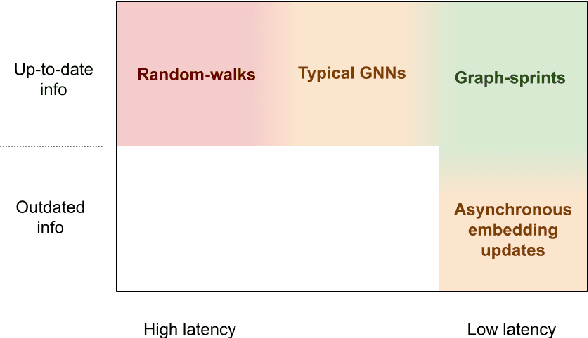

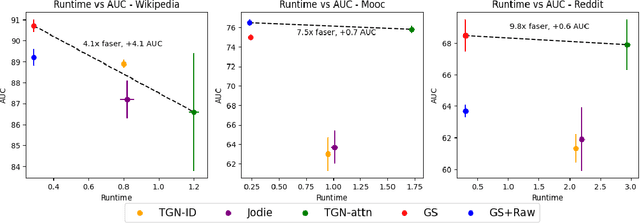

Abstract:Many real-world datasets have an underlying dynamic graph structure, where entities and their interactions evolve over time. Machine learning models should consider these dynamics in order to harness their full potential in downstream tasks. Previous approaches for graph representation learning have focused on either sampling k-hop neighborhoods, akin to breadth-first search, or random walks, akin to depth-first search. However, these methods are computationally expensive and unsuitable for real-time, low-latency inference on dynamic graphs. To overcome these limitations, we propose graph-sprints a general purpose feature extraction framework for continuous-time-dynamic-graphs (CTDGs) that has low latency and is competitive with state-of-the-art, higher latency models. To achieve this, a streaming, low latency approximation to the random-walk based features is proposed. In our framework, time-aware node embeddings summarizing multi-hop information are computed using only single-hop operations on the incoming edges. We evaluate our proposed approach on three open-source datasets and two in-house datasets, and compare with three state-of-the-art algorithms (TGN-attn, TGN-ID, Jodie). We demonstrate that our graph-sprints features, combined with a machine learning classifier, achieve competitive performance (outperforming all baselines for the node classification tasks in five datasets). Simultaneously, graph-sprints significantly reduce inference latencies, achieving close to an order of magnitude speed-up in our experimental setting.
Anti-Money Laundering Alert Optimization Using Machine Learning with Graphs
Dec 14, 2021



Abstract:Money laundering is a global problem that concerns legitimizing proceeds from serious felonies (1.7-4 trillion euros annually) such as drug dealing, human trafficking, or corruption. The anti-money laundering systems deployed by financial institutions typically comprise rules aligned with regulatory frameworks. Human investigators review the alerts and report suspicious cases. Such systems suffer from high false-positive rates, undermining their effectiveness and resulting in high operational costs. We propose a machine learning triage model, which complements the rule-based system and learns to predict the risk of an alert accurately. Our model uses both entity-centric engineered features and attributes characterizing inter-entity relations in the form of graph-based features. We leverage time windows to construct the dynamic graph, optimizing for time and space efficiency. We validate our model on a real-world banking dataset and show how the triage model can reduce the number of false positives by 80% while detecting over 90% of true positives. In this way, our model can significantly improve anti-money laundering operations.
 Add to Chrome
Add to Chrome Add to Firefox
Add to Firefox Add to Edge
Add to Edge